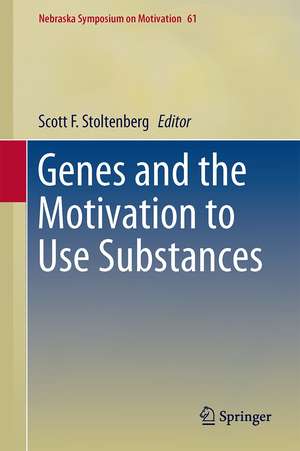Genes and the Motivation to Use Substances: Nebraska Symposium on Motivation, cartea 61
Editat de Scott F. Stoltenbergen Limba Engleză Hardback – 13 iun 2014
| Toate formatele și edițiile | Preț | Express |
|---|---|---|
| Paperback (1) | 633.53 lei 6-8 săpt. | |
| Springer – 3 sep 2016 | 633.53 lei 6-8 săpt. | |
| Hardback (1) | 639.73 lei 6-8 săpt. | |
| Springer – 13 iun 2014 | 639.73 lei 6-8 săpt. |
Din seria Nebraska Symposium on Motivation
-
 Preț: 219.43 lei
Preț: 219.43 lei -
 Preț: 356.35 lei
Preț: 356.35 lei -
 Preț: 367.50 lei
Preț: 367.50 lei -
 Preț: 185.28 lei
Preț: 185.28 lei -
 Preț: 364.62 lei
Preț: 364.62 lei -
 Preț: 361.14 lei
Preț: 361.14 lei - 15%
 Preț: 637.28 lei
Preț: 637.28 lei -
 Preț: 398.42 lei
Preț: 398.42 lei -
 Preț: 362.11 lei
Preț: 362.11 lei - 15%
 Preț: 643.00 lei
Preț: 643.00 lei - 15%
 Preț: 639.73 lei
Preț: 639.73 lei - 15%
 Preț: 642.51 lei
Preț: 642.51 lei - 15%
 Preț: 640.88 lei
Preț: 640.88 lei - 15%
 Preț: 637.13 lei
Preț: 637.13 lei - 20%
 Preț: 551.32 lei
Preț: 551.32 lei - 15%
 Preț: 639.73 lei
Preț: 639.73 lei - 15%
 Preț: 641.85 lei
Preț: 641.85 lei - 15%
 Preț: 643.65 lei
Preț: 643.65 lei - 18%
 Preț: 1003.70 lei
Preț: 1003.70 lei - 18%
 Preț: 786.98 lei
Preț: 786.98 lei - 18%
 Preț: 893.40 lei
Preț: 893.40 lei - 24%
 Preț: 732.54 lei
Preț: 732.54 lei - 18%
 Preț: 727.90 lei
Preț: 727.90 lei - 18%
 Preț: 783.98 lei
Preț: 783.98 lei - 18%
 Preț: 889.29 lei
Preț: 889.29 lei -
 Preț: 440.04 lei
Preț: 440.04 lei -
 Preț: 396.82 lei
Preț: 396.82 lei -
 Preț: 216.31 lei
Preț: 216.31 lei -
 Preț: 438.90 lei
Preț: 438.90 lei -
 Preț: 439.05 lei
Preț: 439.05 lei -
 Preț: 404.28 lei
Preț: 404.28 lei -
 Preț: 434.74 lei
Preț: 434.74 lei -
 Preț: 250.75 lei
Preț: 250.75 lei -
 Preț: 219.61 lei
Preț: 219.61 lei
Preț: 639.73 lei
Preț vechi: 752.63 lei
-15% Nou
Puncte Express: 960
Preț estimativ în valută:
122.43€ • 132.94$ • 102.84£
122.43€ • 132.94$ • 102.84£
Carte tipărită la comandă
Livrare economică 22 aprilie-06 mai
Preluare comenzi: 021 569.72.76
Specificații
ISBN-13: 9781493906529
ISBN-10: 1493906526
Pagini: 156
Ilustrații: IX, 144 p. 21 illus., 9 illus. in color.
Dimensiuni: 155 x 235 x 14 mm
Greutate: 0.4 kg
Ediția:2014
Editura: Springer
Colecția Springer
Seria Nebraska Symposium on Motivation
Locul publicării:New York, NY, United States
ISBN-10: 1493906526
Pagini: 156
Ilustrații: IX, 144 p. 21 illus., 9 illus. in color.
Dimensiuni: 155 x 235 x 14 mm
Greutate: 0.4 kg
Ediția:2014
Editura: Springer
Colecția Springer
Seria Nebraska Symposium on Motivation
Locul publicării:New York, NY, United States
Public țintă
ResearchCuprins
1 Do Genes Motivate Substance Use?.- 2. Rodent Models of Genetic Contributions to Motivation to Abuse Alcohol.- 3 The adolescent origins of substance use disorders: A behavioral genetic perspective.- 4 Genes, Brain, Behavior and Context: The developmental matrix of addictive behavior.- 5 Have the genetics of cannabis involvement gone to pot?.- 6 The DNA Methylation Signature of Smoking: An Archetype for the Identification of Biomarkers for Behavioral Illness.- 7 Genomics of impulsivity: Integrating genes and neuroscience.
Notă biografică
Dr. Stoltenberg holds a PhD in psychology with a focus on behavior genetics from the University of Illinois at Urbana-Champaign. He proceeded to do a NIAAA funded postdoctoral fellowship in human alcoholism genetics at the Addiction Research Center at the University of Michigan. He then joined the University of Michigan research faculty in the Psychiatry Department, where he continued to conduct research into the genetics of alcoholism. In 2004, he took a more teaching-oriented position at Black Hills State University before coming to University of Nebraska in 2009.
Textul de pe ultima copertă
Human beings have been using intoxicating substances for millennia. But while most people have used psychoactive substances without becoming dependent on them, a significant minority develop substance use disorders. The question remains: why does addiction occur in some and not others?
The 61st installment of the Nebraska Symposium on Motivation, Genes and the Motivation to Use Substances probes the complex role of genetics in substance use and abuse across diverse methodologies, research organisms, levels of analysis, and disciplines. Its combined lifespan/motivation approach to individual differences sheds necessary light on genetic vs. environmental factors in vulnerability, addiction risk, the relationship between behavioral disinhibition and substance use, and the motivation to quit. While alcohol use/abuse is the focus of much of the book, its chapters provide scientific and clinical insights into substance abuse in general as well as implications for treatment. And an intriguing conclusion discusses the need to bridge the gap between genetics and neuroscience, and the best scientific conditions in which this integration may thrive. Included in the coverage:
The 61st installment of the Nebraska Symposium on Motivation, Genes and the Motivation to Use Substances probes the complex role of genetics in substance use and abuse across diverse methodologies, research organisms, levels of analysis, and disciplines. Its combined lifespan/motivation approach to individual differences sheds necessary light on genetic vs. environmental factors in vulnerability, addiction risk, the relationship between behavioral disinhibition and substance use, and the motivation to quit. While alcohol use/abuse is the focus of much of the book, its chapters provide scientific and clinical insights into substance abuse in general as well as implications for treatment. And an intriguing conclusion discusses the need to bridge the gap between genetics and neuroscience, and the best scientific conditions in which this integration may thrive. Included in the coverage:
- Rodent models of genetic contributions to the motivation to use alcohol.
- The adolescent origins of substance abuse disorders
- The developmental matrix of addictive behavior
- The genetics of cannabis involvement
- The DNA methylation signature of smoking
- Genomics of impulsivity: integrating genetics and neuroscience.
Caracteristici
Sheds necessary light on genetic vs. environmental factors for addiction risk Suggests how to alter substance abuse treatment according to an individual's genetic code Concluding chapter explores the relationship between genetics and neuroscience in addiction Includes supplementary material: sn.pub/extras










